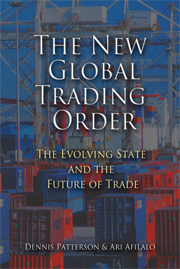Book contents
- Frontmatter
- Contents
- Preface
- 1 Introduction
- 2 The Evolving State
- 3 The Changing Nature of Welfare
- 4 Disaster and Redemption: 1930s and Bretton Woods
- 5 The Transformation of the Bretton Woods World and the Rise of a New Economic Order
- 6 The End of Bretton Woods and the Beginning of a New Global Trading Order
- 7 The Enablement of Global Economic Opportunity
- 8 Trade and Security
- Conclusion
- Notes
- Bibliography
- Index
5 - The Transformation of the Bretton Woods World and the Rise of a New Economic Order
Published online by Cambridge University Press: 02 July 2009
- Frontmatter
- Contents
- Preface
- 1 Introduction
- 2 The Evolving State
- 3 The Changing Nature of Welfare
- 4 Disaster and Redemption: 1930s and Bretton Woods
- 5 The Transformation of the Bretton Woods World and the Rise of a New Economic Order
- 6 The End of Bretton Woods and the Beginning of a New Global Trading Order
- 7 The Enablement of Global Economic Opportunity
- 8 Trade and Security
- Conclusion
- Notes
- Bibliography
- Index
Summary
Thesis:
The trade order of Bretton Woods was the expression of unique world-historical events that wed a trade order to a constitutional order of states. This order was established by the victors of World War II, who chose an international trade order that accorded with the nature of their Statecraft. Today, the nation-state is fading and its trade order – comparative advantage – is also under increasing pressure. Additionally, economic activity capacity is globally dispersed. The cross-border enterprise is the hallmark of the new global trade order as states move from a norm of comparative advantage to enablement of economic opportunity. To complete the next constitutional cycle, a post-modern Statecraft constitutional structure must be at the core of future global trade policy.
Bretton Woods inherited and shaped a world subdivided into national economies coextensive with the nation-states that established the trade order of the GATT. As described in Chapter 4, the theoretical foundation of the system respected sovereignty, left it to internal domestic policy to control the redistribution of wealth and to provide for the well-being of the subjects of the nation-state, and removed protectionist trade restrictions as a tool of governmental regulation. The structural changes implemented by Bretton Woods accorded with the face of modern Statecraft. Pre-modern Statecraft involved an inward-looking movement of solidification of the State, drawing on its labor pool, its colonization conquests, and the industrial resources that were created as a byproduct of the pre-modern enterprise. For the state-nation, mercantilism made sense.
- Type
- Chapter
- Information
- The New Global Trading OrderThe Evolving State and the Future of Trade, pp. 81 - 109Publisher: Cambridge University PressPrint publication year: 2008



